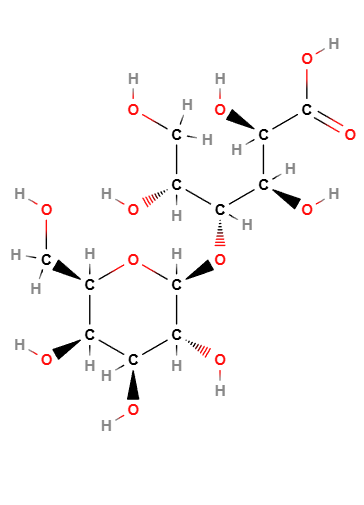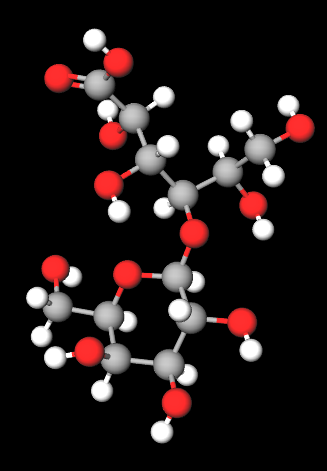Lactobionic acid is an organic acid used in cosmetic and pharmaceutical products for its exfoliating and hydrating properties. It is a derivative of lactose and is used to improve skin health and address various skin issues.
Chemical Composition and Structure
Lactobionic acid is a disaccharide derived from lactose, consisting of two sugar units: galactose and glucose. Its chemical structure includes a carboxyl group that imparts its acidic properties and a cyclic structure that contributes to its stability. The lactobionic acid molecule features a piranosic ring with two hydroxyl groups, which enhance its ability to bind water and provide moisturizing benefits.
Physical Properties
Lactobionic acid appears as a white powder or colorless crystals. It is soluble in water and has an acidic pH, which is compatible with cosmetic formulations. It has high solubility in water and tends to be well-tolerated by the skin, with a low risk of irritation.
Production Process
The production of lactobionic acid involves several key steps:
- Synthesis Lactobionic acid is produced by the oxidation of lactose, a disaccharide composed of galactose and glucose. This oxidation process is carried out using oxidizing agents such as hydrogen peroxide, which converts lactose into lactobionic acid.
- Purification After synthesis, lactobionic acid is purified to remove any impurities and by-products. Purification methods may include filtration, crystallization, and other techniques to ensure a pure and stable product.
- Formulation The purified lactobionic acid is incorporated into cosmetic and pharmaceutical formulations. It may be mixed with other ingredients to create serums, creams, lotions, and exfoliating products.
- Quality Control The final product undergoes quality control testing to ensure it meets safety, efficacy, and performance standards. This includes checks for purity, stability, and compatibility with other ingredients.
- Storage Lactobionic acid is stored in airtight containers, protected from light, moisture, and heat, to maintain its stability and effectiveness.
Applications
Medical Lactobionic acid is used in pharmaceutical preparations for its antioxidant and hydrating properties (12). It is employed in treatments to improve skin texture and address conditions such as dry and flaky skin.
Cosmetics In cosmetics, lactobionic acid is valued for its ability to gently exfoliate the skin without irritation. It is used in serums, creams, and lotions to improve skin appearance, reduce the visibility of wrinkles, and enhance hydration (2).
Others It can be incorporated into skincare products and anti-aging treatments to utilize its exfoliating and hydrating benefits.
Cosmetics - INCI Functions
- Buffering agent. It is an iingredient that can bring an alkaline or acid solution to a certain pH level and prevent it from changing, in practice a pH stabiliser that can effectively resist instability and pH change.
Environmental and Safety Considerations
Lactobionic acid is generally considered safe for use in cosmetic and pharmaceutical products when used according to recommended guidelines. It is well-tolerated by the skin and has a low risk of irritation. Environmentally, the production of lactobionic acid is relatively sustainable, but it is important to follow responsible manufacturing practices to minimize environmental impact. Safety considerations include monitoring for potential allergic reactions or sensitivities in some individuals.
Molecular Formula C12H22O12
Molecular Weight
CAS 96-82-2
UNII 65R938S4DV
EC Number 202-538-3
Synonyms:
Lactobionate
maltobionic-acid
References__________________________________________________________________________
(1) Goderska K. The antioxidant and prebiotic properties of lactobionic acid. Appl Microbiol Biotechnol. 2019 May;103(9):3737-3751. doi: 10.1007/s00253-019-09754-7.
Abstract. The aim of this research was to analyze the antioxidant and prebiotic properties of lactobionic acid and to develop a method of producing it from whey using the bacterium Pseudomonas taetrolens. Prebiotic properties were tested with selected bacterial strains that exhibit probiotic properties, while the antioxidant efficacy was tested using cold-pressed rapeseed oil. A particularly evident prebiotic effect was observed with the bacterium Lactobacillus fermentum with a lactobionic acid concentration of 16 mg/cm3. The growth curves of microorganisms in a substrate with various levels of lactobionic acid showed similarities between Lactococcus lactis, Lactobacillus acidophilus DSM 20242, Lactobacillus acidophilus L-AH1, Lactobacillus acidophilus NCDO, Lactobacillus delbrueckii A, Lactobacillus casei, Lactobacillus casei Shirota, Bifidobacterium bifidum DSM 20215, and Bifidobacterium bifidum DSM 20456, where a short logarithmic growth phase could be distinguished, in comparison to the growth of Lactobacillus fermentum and Lactobacillus acidophilus CH-5, where the logarithmic growth phase was extended. Bifidobacterium bifidum DSM 20082 and Bifidobacterium bifidum DSM 20239 form a separate group. The greater the amount of lactobionic acid added, the higher its activity. The greatest oxidation inhibition efficacy in rapeseed oil was recorded on day 10 of storage at 60 °C with an acid content of 10 mg/cm3. Expressed as a percentage reduction of peroxide value, this effect was 19.6%. The best result for preparations of lactobionic acid were found at 1 cm3 (22.03 mg/cm3), amounting to 7.3% on day 10 of the rapeseed oil thermostat test.
(2) Tasic-Kostov M, Savic S, Lukic M, Tamburic S, Pavlovic M, Vuleta G. Lactobionic acid in a natural alkylpolyglucoside-based vehicle: assessing safety and efficacy aspects in comparison to glycolic acid. J Cosmet Dermatol. 2010 Mar;9(1):3-10. doi: 10.1111/j.1473-2165.2010.00474.x.
Abstract. Background/aims: Lactobionic acid (LA) is a newer cosmeceutical active belonging to the class of alpha-hydroxyacids (AHAs), showing advantages over them. The aim of part I of this study was to compare efficacy and irritation potential of LA vs. glycolic acid (GA) from two types of vehicles - gel and emulsion. In part II, effects of LA-containing emulsions based on a new, natural emulsifier of alkylpolyglucoside (APG) type were evaluated. Methods: Skin bioengineering was used on 77 healthy volunteers to assess: color as erythema and melanin (MI) index, transepidermal water loss, electrical capacitance and pH of the skin. In part I of the study, the parameters were measured after occlusion and periodically during 2 weeks of test samples application; in part II parameters were measured periodically during 4 weeks. Results/conclusion: LA-containing samples has produced better skin performance when compared with corresponding GA-containing ones, particularly the lack of both skin irritation and skin barrier impairment. When used in vehicles based on a new APG-emulsifier, LA and GA have shown better efficacy, emphasizing the importance of vehicle on the effects of topical actives. LA (6%) in the emulsion based on APGs could be proposed as an alternative to low-molecular AHAs in cosmeceuticals.
Algiert-Zielińska B, Mucha P, Rotsztejn H. Comparative evaluation of skin moisture after topical application of 10% and 30% lactobionic acid. J Cosmet Dermatol. 2018 Dec;17(6):1096-1100. doi: 10.1111/jocd.12485. Epub 2018 Jan 9. PMID: 29318715.
![]() Lactobionic acid
Lactobionic acid 


